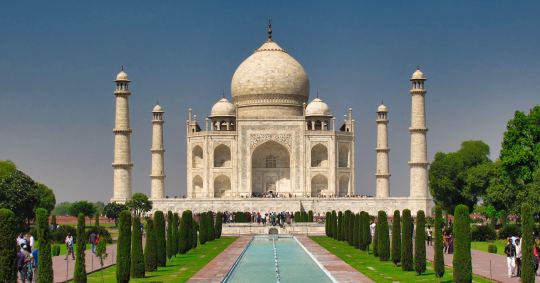Don't wanna be here? Send us removal request.
Text
Discovering the Soul of India: A Journey Through Its Enchanting Destinations
India, a land where tradition meets modernity and spirituality intertwines with bustling city life, is a traveler's paradise. From the snow-capped peaks of the Himalayas to the sun-kissed beaches of Goa, every corner of this diverse nation tells a story, painting a picture of a country steeped in history and culture.
Our journey begins in the iconic city of Agra, home to one of the Seven Wonders of the World, the Taj Mahal. Standing as a testament to eternal love, this marble masterpiece mesmerizes visitors with its exquisite architecture and poignant history. As the sun rises, casting a golden glow upon the monument, one can't help but feel the romance that lingers in the air.
Venturing southward, we find ourselves amidst the bustling streets of Mumbai, India's financial capital. Here, the spirit of Bollywood mingles with the aroma of street food, creating a sensory overload that is uniquely Mumbai. From the Gateway of India to the Elephanta Caves, every corner of the city reflects its colonial past and vibrant present.
No journey through India is complete without experiencing the spiritual aura of Varanasi, the oldest continuously inhabited city in the world. The ghats of the Ganges River come alive with devotees, rituals, and the soft strains of ancient hymns. Witnessing the evening Ganga Aarti, where lamps are floated on the river as offerings to the divine, is a soul-stirring experience.
As we travel further south, the tranquil backwaters of Kerala invite us to unwind and connect with nature. Cruising on traditional houseboats, surrounded by lush greenery and the melodies of exotic birds, offers a peaceful retreat from the hustle and bustle of modern life. Kerala's rich culinary scene, infused with coconut, spices, and fresh seafood, tantalizes the taste buds, making every meal a delightful adventure.
Our journey concludes in the mystical city of Varanasi, where ancient temples and ashrams dot the landscape, creating an atmosphere of spirituality and introspection. Here, the convergence of cultures and religions is palpable, making it a melting pot of beliefs and traditions.
In every city, every temple, and every smile exchanged, we discover the soul of India. It's not just a country; it's an experience that leaves an indelible mark on the heart. As we bid farewell, we carry with us not just memories, but a profound understanding that India is not just a destination; it's a journey of the soul.
#Travel Blog#Tourism#Travel Adventures#Destination Guides#Cultural Exploration#Wanderlust#Travel Stories#Adventure Travel#Solo Travel#Family Vacations#Budget Travel#Travel Photography#Local Cuisine
1 note
·
View note
Text

Join Our Community: Become a part of our global travel tribe! Share your own adventures, tips, and must-visit places. Let's connect, inspire, and wander together. Tag us in your travel stories and use our official hashtag to feature on our page
#TravelBlogger#TravelBlog#Wanderlust#ExploreWorld#AdventureTravel#TravelTips#TravelInspiration#BucketList#SoloTravel#FamilyTravel
0 notes
Text

TOP 5 Veg protein source
1. Getting enough protein. Protein is an essential nutrient used for maintaining muscles and bones, as well as supporting the immune system, among other things. It’s a common misconception that it’s difficult to get enough protein if you don’t eat meat, but studies show that most vegetarians and vegans meet their protein needs. While it’s somewhat easier to get adequate protein on a vegetarian diet, which includes high-quality sources such as milk, cheese, cottage cheese, and eggs, it is still possible to consume an adequate intake of protein on a vegan diet.
2. An excellent protein package. Many plant proteins, including beans, lentils, and soy all come packed with other beneficial nutrients like fiber, vitamins, minerals, healthy fat, and phytochemicals, and little of the “bad stuff,” like saturated fat, sodium and cholesterol.
3. Complementary proteins are a thing of the past. It was once thought that plant proteins—typically providing a lower percentage of at least one amino acid—needed to be “combined,” by mixing grains and legumes in order to make a “complete” protein. However, now we know that the body creates a pool of the various essential amino acids, so it’s not critical to combine them all in one meal.
4. Vegans may require a slightly more protein, due to the slight decrease in digestibility in plant proteins. Vegans can obtain protein in a variety of plant foods, including legumes, soy foods, whole grains, nuts, seeds, and even vegetables. These estimates may vary, but studies show that a level of 1.0 to 1.1 g/kg of protein may be an appropriate level to compensate for digestibility. In addition, new research suggests that older adults (over 60 years of age) may benefit, in terms of optimal muscle and bone mass, from slightly higher intakes of protein than is currently recommended in the Recommended Dietary Allowance (RDA) to levels of about 1.0 to 1.2 g/kg/day
Tips to Meet Your Needs
1. Include a protein source at each meal and snack. Balance each meal with a good source of protein.
Breakfast: Combine whole grains, nuts and seeds; or sauté beans, tofu, and vegetables.
Lunch: Build a sandwich with whole grain bread, nut butter or tahini, baked tofu or tempeh, and veggies. Add proteinrich soups, such as bean, pea or lentil; and include protein sources in salads, such as tofu, beans, nuts, and seeds.
Dinner: Simmer legumes and serve them with whole grains or whole grain bread, and vegetables. Or stir-fry tofu, seitan or tempeh with vegetables and grains.
Snack: Pour protein-rich, plant-based milk in your coffee and cereal.
2. Vegetarian add-ons. If you’re a vegetarian, you should still power up on plant proteins, but you also can add 2 to 3 servings of dairy foods every day, and a few egg servings each week
3. Read food labels. Make sure your food choices are rich in nutrients, including protein. Look for protein in plant-based yogurts and milks, cereals, breads, and snack foods.
1 note
·
View note
